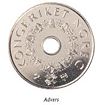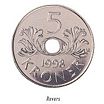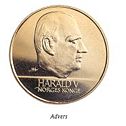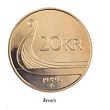Norwegian krone
| Norwegian krone norsk krone (Norwegian) |
|||||
|
|||||
| ISO 4217 Code | NOK | ||||
|---|---|---|---|---|---|
| User(s) | |||||
| Inflation | 2.3% | ||||
| Source | The World Factbook, 2006 est. | ||||
| Subunit | |||||
| 1/100 | øre | ||||
| Symbol | kr | ||||
| Plural | kroner | ||||
| øre | øre | ||||
| Coins | 50 øre, 1, 5, 10, 20 kr | ||||
| Banknotes | 50, 100, 200, 500, 1000 kr | ||||
| Central bank | Bank of Norway | ||||
| Website | www.norges-bank.no | ||||
The krone (sign: kr; code: NOK) is the currency of Norway. The plural form is kroner. It is subdivided into 100 øre (singular and plural are the same). The ISO 4217 code is NOK, although the common local abbreviation is kr. The name translates into English as "crown".
Contents |
History
The krone was introduced in 1875, replacing the Norwegian speciedaler at a rate of 4 kroner = 1 speciedaler. In doing so, Norway joined the Scandinavian Monetary Union, which had been established in 1873. The Union persisted until 1914 but, after its dissolution, Denmark, Norway and Sweden all decided to keep the names of their respective and now separate currencies.
Within the Scandinavian Monetary Union, the krone was on a gold standard of 2480 kroner = 1 kilogram of pure gold (1 krone = 403.226 milligrams gold). This gold standard was restored between 1916 and 1920 and again in 1928 but was suspended permanently in 1931, when a peg to the British pound of 19.9 kroner = 1 pound was established (the previous rate had been 18.16 kroner = 1 pound). In 1939, Norway pegged the krone to the U.S. dollar at a rate of 4.4 kroner = 1 dollar.
During the German occupation in the Second World War, the krone was pegged to the Reichsmark at a rate of 1 krone = 0.6 Reichsmark initially, later reduced to 0.57. After the war, a rate of 20 kroner = 1 pound (4.963 kroner = 1 U.S. dollar) was established. The rate to the pound was maintained in 1949 when the pound devalued relative to the U.S. dollar, leading to a rate of 7.142 kroner = 1 U.S. dollar.
Coins
In 1875, coins were introduced (some dated 1874) in denominations of 10 and 50 øre and 1, 10 and 20 krone. These coins also bore the denomination in the previous currency, as 3, 15 and 30 skilling and 2½ and 5 specidaler. Between 1875 and 1878, the new coinage was introduced in full, in denominations of 1, 2, 5, 10, 25 and 50 øre and 1, 2, 10 and 20 krone. The 1, 2 and 5 øre were bronze, the 10, 25 and 50 øre and 1 and 2 kroner were silver, whilst the 10 and 20 kroner were gold.
The last gold coins were issued in 1910, with silver being replaced by cupro-nickel from 1920. Between 1917 and 1921, iron temporarily replaced bronze. 1917 also saw the last issuance of 2 kroner coins. During the German occupation in WWII, zinc was used in place of cupro-nickel in the 10, 25 and 50 øre, with production of the 1 krone suspended.
In 1963, 5 kroner coins were introduced, whilst, in 1972, production of 1 and 2 øre coins ceased. In 1973, the size of the 5 øre coin was reduced, with the denomination ceasing production in 1982, along with the 25 øre. 10 kroner coins were introduced in 1983. In 1992, the last 10 øre coins were minted. Between 1994 and 1998, a new coinage was introduced, consisting of 50 øre, 1, 5, 10 and 20 kroner, with the 20 kroner introduced in 1994.
| Coins of the Norwegian krone |
  50 øre (1996); King's crown, fable animal |
  1 kr (1997); Harald V's monogram, a fowl |
  5 kr (1998); St.Olav's Order, acanthi leaves |
  10 kr (1995); Harald V, stave church roof |
  20 kr (1994); Harald V, viking ship |
The 10- and 20-kroner coins carry the effigy of the current monarch. Previously the 1- and 5-kroner coins also carried the royal effigy, but now these denominations are only decorated with stylistic royal or national symbols. The royal motto of the monarch (King Harald's motto is Alt for Norge, meaning Everything for Norway) is also inscribed on the 10-kroner coin.
The coins and banknotes are distributed by the Central Bank of Norway.
Banknotes
In 1877, Norges Bank introduced notes for 5, 10, 50, 100, 500 and 1000 kroner. In 1917, 1 krone notes were issued, with 2 kroner notes issued between 1918 and 1922. Because of metal shortages, 1 and 2 kroner notes were again issued between 1940 and 1950. In 1963, 5 kroner notes were replaced by coins, with the same happening to the 10 kroner notes in 1984. 200 kroner notes were introduced in 1994.
| Banknotes of the Norwegian krone |
50 kr; Peter Christen Asbjørnsen |
100 kr; Kirsten Flagstad |
200 kr; Kristian Birkeland |
500 kr; Sigrid Undset |
1000 kr; Edvard Munch |
Summary of denominations issued
| Denomination | Notes | Coins | ||||
|---|---|---|---|---|---|---|
| Printed | Invalid | Comments | Minted | Invalid | Comments | |
| 1 øre | - | 1876-1972 | 1998 | Bronze, iron 1918-21 & 1941-45 | ||
| 2 øre | - | 1876-1972 | 1998 | Bronze, iron 1917-20 & 1943-45 | ||
| 5 øre | - | 1875-1982 | 1998 | Bronze, iron 1917-20 & 1941-45 | ||
| 10 øre | - | 1874-1991 | 2003 | Silver 1874-1919, cupro-nickel 1920-92 (holed 1924-51), zinc 1941-45 | ||
| 25 øre | - | 1876-1982 | 1998 | Silver 1876-1919, cupro-nickel 1921-82 (holed 1921-50), zinc 1943-45 | ||
| 50 øre | - | 1874 | - | Silver 1874-1919, cupro-nickel 1920-96 (holed 1920-49), zinc 1941-45, bronze 1996- | ||
| 1 krone | 1917-1925 1940-1950 |
1926 1999 |
War time "coin notes" | 1875- | - | Silver 1875-1917, cupro-nickel 1925- (holed 1925-51, 1997-) |
| 2 kroner | 1918-1925 1940-1950 |
1926 1999 |
War time "coin notes" | 1876-1917 | ?? | Silver 1878-1917 |
| 5 kroner | 1877-1963 | 1999 | Replaced by coin 1963 | 1963- | - | Cupro-nickel (holed 1998-) |
| 10 kroner | 1877-1984 | 1999 | Replaced by coin 1984 | 1983- | - | Nickel-brass |
| 20 kroner | - | 1994- | - | Nickel-brass | ||
| 50 kroner | 1877- | - | - | |||
| 100 kroner | 1877- | - | - | |||
| 200 kroner | 1994- | - | - | |||
| 500 kroner | 1877- | - | - | |||
| 1000 kroner | 1877- | - | - | |||
Exchange rates
The value of Norwegian kroner compared to other currencies varies considerably from one year to another, mainly based on changes in oil prices and interest rates.
In 2002 the Norwegian krone grew to record high levels against the United States dollar and the Euro. On January 2, 2002, 100 NOK were worth around 11 USD (1 USD=9 NOK). In July 2002, the krone hit a high at 100 NOK = 13.7 USD (1 USD=7.36 NOK). In addition to the high level of interest, which increased further on July 4, 2002, to 7 per cent, the price of oil was high. At the time Norway was the world's third largest oil exporter.
In 2005, oil prices reached record levels of more than 60 dollars per barrel. Although interest rates had decreased to around 2 per cent, the Norwegian krone grew even stronger.
However, in late 2007 and early 2008, the USD suffered a steady depreciation against all other major currencies. The Norwegian krone was gaining value at the same time; as a result, the Norwegian krone became stronger than ever compared to the USD, making the USD worth about 5 NOK in April 2008. By October 2008, the USD had recovered and was worth approxiamately 7 NOK.
| From Yahoo! Finance: | AUD CAD CHF EUR GBP HKD JPY USD SEK DKK |
| From XE.com: | AUD CAD CHF EUR GBP HKD JPY USD SEK DKK |
| From OANDA.com: | AUD CAD CHF EUR GBP HKD JPY USD SEK DKK |
Possible elimination of the 1000 kroner bill
In June 2007, Norwegian politician Heikki Holmås suggested eliminating the 1,000 kroner bill as a means of dealing with crimes such as tax evasion. It was also argued that eliminating the bill would complicate bank robberies, as one million kroner in 500 kroner bills weighs twice as much as the same amount in 1,000 kroner bills, making it more difficult for robbers to physically carry vast amounts of money. The 1,000-krone bill is not widely circulated as people generally use debit cards or other forms of electronic payment for large purchases. Økokrim (the financial investigation branch of the Norwegian police) and Kredittilsynet (The Financial Supervisory Authority of Norway) expressed a positive interest in this proposal. [1]
See also
- Table of historical exchange rates
- Scandinavian Monetary Union
- Swedish krona
- Danish krone
- Economy of Norway
References
- ↑ Ønsker mindre sedler (Wanting smaller money bills) Aftenposten, June 8, 2007 (Norwegian)
External links
|
|||||||||||
|
|||||||||||||||||||||||||||||